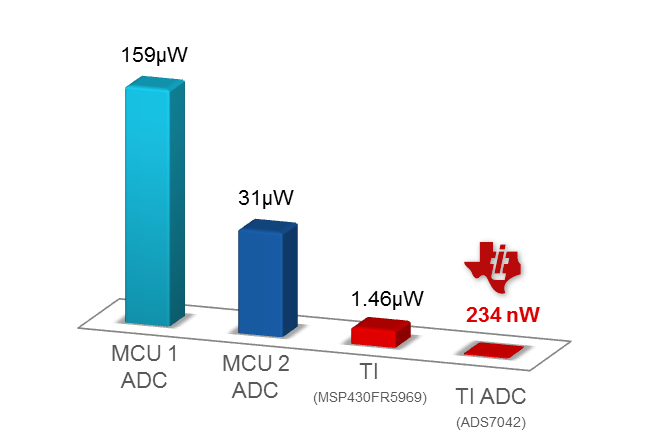The analog-to-digital converter (ADC) is an important component of any system. So important, in fact, that it is often included as a peripheral in many modern microcontrollers (MCUs). But not all ADCs are created equal and if you are designing for ultra-low power, you may want to take a second look at how your ADC is performing at a system level.
Ever catch yourself asking “what resolution and type do I need?”
A common question when dealing with ADCs is what resolution is appropriate for a particular application? With TI’s broad portfolio of ADCs, you have options from 8-bit all the way to 24-bit resolution. A higher resolution means more detail, but for many applications, a lower resolution may be all you need. For example, measuring the ambient temperature of a room could be done by pairing TI’s LMT89 temperature sensor with a 12-bit ADC, such as the ADS7042 to convert the analog temperature data into digital data over a SPI interface.
There are also different styles of ADCs. The first type are successive approximation (SAR) converters, which determine the digital output by sampling the input signal and comparing the voltage to an internal set of finely tuned capacitor banks. Delta-sigma converters are another type; they determine the digital output by oversampling and applying digital filtering. SAR ADCs offer zero cycle-latency, high speed, high accuracy, low power and ease of use, but trade off in lower resolution. Delta-sigma ADCs provide high resolution and stability, but operate at lower speeds and higher cycle-latency.
SAR ADCs are best for general-purpose applications, such as data loggers and sensors. As long as you need less than 4MSPS bandwidth, the SAR ADC is the right choice.
 What’s the advantage of an external ADC?
What’s the advantage of an external ADC?
One question you may have is if an ADC is already included in your MCU, why would it make sense to add an external one? The answer is pretty surprising. For some applications, we may simply want greater resolution on the ADC channel. What’s not intuitive is the power savings that can be achieved by using an external ADC. Normally to save power you want to remove parts from the system, but in this case, adding an ADC helps. By shutting down the main MCU ADC you can see staggering power savings.
In the graph above, you can clearly see that utilizing an external ADC is key to reducing power consumption. And with the ADS7042 being the industry’s smallest 12-bit, 1MSPS SAR ADC, it does not have a major impact on board space.
ADCs – They’re as easy as 1-2-3
Get started with ADS7042 BoosterPack™ plug-in module and the ultra-low-power MSP430FR4133 MCU LaunchPad™ development kit. The MSP430™ microcontroller has a wide variety of programming options. The ultra-small 8-pin QFN package of the ADS7042, combined with its ultra-low power consumption, is well-suited for applications where reducing power consumption and design size is paramount. The BoosterPack module also contains a TI Precision Voltage Reference (REF3330) and several precision Op-Amps (OPA316 and OPA378) in addition to an on-board ambient light sensor.
To get started, check out more information on these products at ti.com/ADS7042BoosterPack
You can also learn more about TI’s precision ADCs at ti.com/precisionadc
You can also read about more design techniques using low-power analog components that can help optimize overall system power consumption, “How low can you go? How to reduce power consumption in data-acquisition systems” by my colleague Peggy Liska.
Check out our latest RoadTest review of our ADS7042 BoosterPack and MSP430FR4133 through Premier Farnell's element 14 community.
